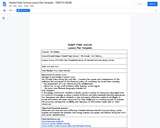
Students will research and debate the presidential terms of Gerald Ford and Jimmy Carter.
- Subject:
- American History
- Social Studies
- Material Type:
- Lesson
- Provider:
- Michigan Virtual
- Author:
- Tim Beebe
- Date Added:
- 04/26/2017

Students will research and debate the presidential terms of Gerald Ford and Jimmy Carter.
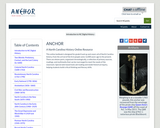
This online textbook is designed for grade 8 and up and covers all of North Carolina history, from the arrival of the first people some 12,000 years ago to the present. There are eleven parts, organized chronologically, a collection of primary sources, readings, and multimedia that can be rearranged to meet the needs of the classroom. Special web-based tools aid reading and model historical inquiry, helping students build critical thinking and literacy skills.

Containing more than 50 articles from the award-winning Tar Heel Junior Historian magazine and over 40 lesson plans, this multidisciplinary Educator Notebook will enrich your exploration of North Carolina and American history with diverse perspectives. This resource's link takes you to a very short form that gives you free downloadable access to the complete PDF book.
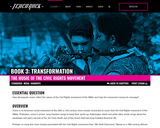
In this lesson, students will examine the history and popularity of "We Shall Overcome" and investigate six additional songs from different musical genres that reveal the impact of the Civil Rights movement. These are: Billie Holiday's "Strange Fruit," a poignant Blues song depicting the horrors of lynching; Bob Dylan's "Oxford Town," a Folk song about protests after the integration of the University of Mississippi; John Coltrane's "Alabama," an instrumental Jazz recording made in response to the September 1963 church bombing in Birmingham, Alabama, that killed four African-American girls; Nina Simone's "Mississippi Goddam," a response to the same church bombing as well as the murder of civil rights activist Medgar Evers in Mississippi; Sam Cooke's "A Change is Gonna Come," a Soul song written after Cooke's arrest for attempting to check in to a whites-only motel in Shreveport, Louisiana; and Odetta's "Oh Freedom," a spiritual that Odetta performed at the 1963 March on Washington.
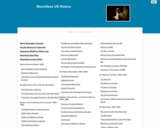
Full course with electronic textbook, quiz files, and lecture slides for US History.
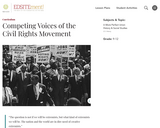
When most people think of the Civil Rights Movement in America, they think of Martin Luther King, Jr. Delivering his "I Have a Dream" speech on the steps of the Lincoln Memorial in 1963. But "the Movement" achieved its greatest results due to the competing strategies and agendas of diverse individuals.

Freedom’s Ring is Martin Luther King, Jr.’s “I Have a Dream” speech, animated. Here you can compare the written and spoken speech, explore multimedia images, listen to movement activists, and uncover historical context. Fifty years ago, as the culminating address of the March on Washington for Jobs and Freedom, King demanded the riches of freedom and the security of justice. Today, his language of love, nonviolent direct action, and redemptive suffering resonates globally in the millions who stand up for freedom together and elevate democracy to its ideals. How do the echoes of King’s Dream live within you?
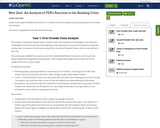
Students will analyze President Roosevelt's first 2 fireside chats and evaluate his proposed programs that outline the New Deal.This lesson is adapted from the NEH and EDSITEment.
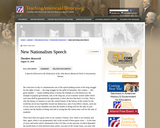
Theodore Roosevelt's speech addressed the challenges the United States experienced after the Civil War.
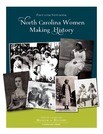
This Educator Notebook provides information on Women’s History in North Carolina for teachers to use as a resource, either as stand-alone units, or integrated into standard curriculum. Included is research from museum curators and educators, and articles published in the Tar Heel Junior Historian magazine which are written for students in grades 4-12. Lesson plans and suggested activities complement many of the topics. Adaptable to multiple ages, they meet curriculum goals set forth by the NC Department of Public Instruction and connect to classes in national and world history, geography, economics, and the arts, and can be part of any unit of social studies. This resource's link takes you to a very short form that gives you free downloadable access to the complete PDF book.
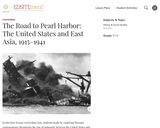
The 1930s saw a steadily increasing campaign of Japanese aggression in China, beginning with the invasion of Manchuria in 1931 and culminating in the outbreak of full-scale war between the two powers in 1937. Each instance of aggression resulted in denunciations from the United States, but the administrations of the time understood that there was no will on the part of the American public to fight a war in East Asia.
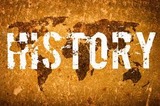
Within U.S. History II, I encoutnered two issuesOne: how to assist students in developing connections between past events and today's world.Two, how to present hsitorical content to studnets while teaching another specific disipline.So, I developed a graphic organizer for each decade of the 20th Century that fosucses on not necessarily "dry" historical content, but instead on more culturally impacting events on American lives, using videos from www.history.com. Students were provided with the graphic organizer packet and the video segment was loaded onto the library computer, (so that I could be working with students in U.S. History I at the same time in another location).Students would review the video segment, usually not focusing on a specifiic historical eventcovered in class, but more about American culture during the time period being reviewed, such as (in)famous individuals, physical items such as toys used in the time period/decade, news events and occurrences such as sporting activities, etcStudents would then need to analyze an audio/visual lesson on a partiuclar subject, but also to formulate a connection between that subject and the world today.

The High School United States History MI Open Book takes students on a journey through the final chunk of U.S. History first started in fifth and continued in eighth grades respectively.